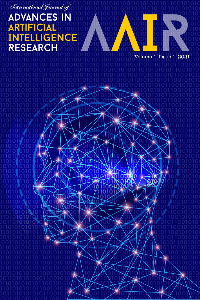Abstract
References
- M. A. Anusuya and S. K. Katti. “Speech Recognition by Machine, A Review”. In: International Journal of Computer Science and Information Security, IJCSIS, Vol. 6, No. 3, pp. 181-205, December 2009, USA (Jan. 2010).
- Han, Wei, et al. "An efficient MFCC extraction method in speech recognition." 2006 IEEE international symposium on circuits and systems. IEEE, 2006.
- Jiang, Fei, et al. "An event recognition method for fiber distributed acoustic sensing systems based on the combination of MFCC and CNN." 2017 International Conference on Optical Instruments and Technology: Advanced Optical Sensors and Applications. Vol. 10618. International Society for Optics and Photonics, 2018.
- Warden, Pete. "Speech commands: A dataset for limited-vocabulary speech recognition." arXiv preprint arXiv:1804.03209 (2018).
- S. Davis and P. Mermelstein. “Comparison of parametric representations for monosyllabic word recognition in continuously spoken sentences”. In: IEEE Transactions on Acoustics, Speech, and Signal Processing 28.4 (Aug. 1980), pp. 357–366.
- Harshita Gupta and Divya Gupta. “LPC and LPCC method of feature extraction in Speech Recognition System”. In: 2016 6th International Conference - Cloud System and Big Data Engineering (Confluence). IEEE, Jan. 2016.
- D.J. Mashao, Y. Gotoh, and H.F. Silverman. “Analysis of LPC/DFT features for an HMM-based alphadigit recognizer”. In: IEEE Signal Processing Letters 3.4 (Apr. 1996), pp. 103–106.
- Y. Lecun et al. “Gradient-based learning applied to document recognition”. In: Proceedings of the IEEE 86.11 (1998), pp. 2278–2324.
- Hamed Habibi Aghdam and Elnaz Jahani Heravi. “Traffic Sign Detection and Recognition”. In: Guide toConvolutional Neural Networks. Springer International Publishing, 2017, pp. 1–14.
- Dan Claudiu Ciresan et al. “Convolutional Neural Network Committees for Handwritten Character Classification”. In: 2011 International Conference on Document Analysis and Recognition. IEEE, Sept. 2011.
- Krizhevsky, Alex, Ilya Sutskever, and Geoffrey E. Hinton. "Imagenet classification with deep convolutional neural networks." Advances in neural information processing systems. 2012.
Abstract
In this paper, an automatic speech recognition system based on convolutional neural networks and MFCC has been proposed. We have been investigated some deep models’ architecture with various hyperparameters options such as Dropout rate and Learning rate. The dataset used in this paper was collected from Kaggle TensorFlow Speech Recognition Challenge. Each audio file in the dataset contain one word with one second length the total words in the dataset correspond to 30 categories with one category for background noise. The dataset contains 64,721 files has been separated into 51,088 for the training set, 6,798 for the validation set and 6,835 for the testing set. We have evaluated 3 models with different hyperparameters configuration in order to choose the best model with higher accuracy. The highest accuracy achieved is 88.21%.
References
- M. A. Anusuya and S. K. Katti. “Speech Recognition by Machine, A Review”. In: International Journal of Computer Science and Information Security, IJCSIS, Vol. 6, No. 3, pp. 181-205, December 2009, USA (Jan. 2010).
- Han, Wei, et al. "An efficient MFCC extraction method in speech recognition." 2006 IEEE international symposium on circuits and systems. IEEE, 2006.
- Jiang, Fei, et al. "An event recognition method for fiber distributed acoustic sensing systems based on the combination of MFCC and CNN." 2017 International Conference on Optical Instruments and Technology: Advanced Optical Sensors and Applications. Vol. 10618. International Society for Optics and Photonics, 2018.
- Warden, Pete. "Speech commands: A dataset for limited-vocabulary speech recognition." arXiv preprint arXiv:1804.03209 (2018).
- S. Davis and P. Mermelstein. “Comparison of parametric representations for monosyllabic word recognition in continuously spoken sentences”. In: IEEE Transactions on Acoustics, Speech, and Signal Processing 28.4 (Aug. 1980), pp. 357–366.
- Harshita Gupta and Divya Gupta. “LPC and LPCC method of feature extraction in Speech Recognition System”. In: 2016 6th International Conference - Cloud System and Big Data Engineering (Confluence). IEEE, Jan. 2016.
- D.J. Mashao, Y. Gotoh, and H.F. Silverman. “Analysis of LPC/DFT features for an HMM-based alphadigit recognizer”. In: IEEE Signal Processing Letters 3.4 (Apr. 1996), pp. 103–106.
- Y. Lecun et al. “Gradient-based learning applied to document recognition”. In: Proceedings of the IEEE 86.11 (1998), pp. 2278–2324.
- Hamed Habibi Aghdam and Elnaz Jahani Heravi. “Traffic Sign Detection and Recognition”. In: Guide toConvolutional Neural Networks. Springer International Publishing, 2017, pp. 1–14.
- Dan Claudiu Ciresan et al. “Convolutional Neural Network Committees for Handwritten Character Classification”. In: 2011 International Conference on Document Analysis and Recognition. IEEE, Sept. 2011.
- Krizhevsky, Alex, Ilya Sutskever, and Geoffrey E. Hinton. "Imagenet classification with deep convolutional neural networks." Advances in neural information processing systems. 2012.
Details
| Primary Language | English |
|---|---|
| Subjects | Artificial Intelligence |
| Journal Section | Research Articles |
| Authors | |
| Publication Date | January 15, 2021 |
| Acceptance Date | November 25, 2020 |
| Published in Issue | Year 2021 Volume: 1 Issue: 1 |

Graphic design @ Özden Işıktaş


